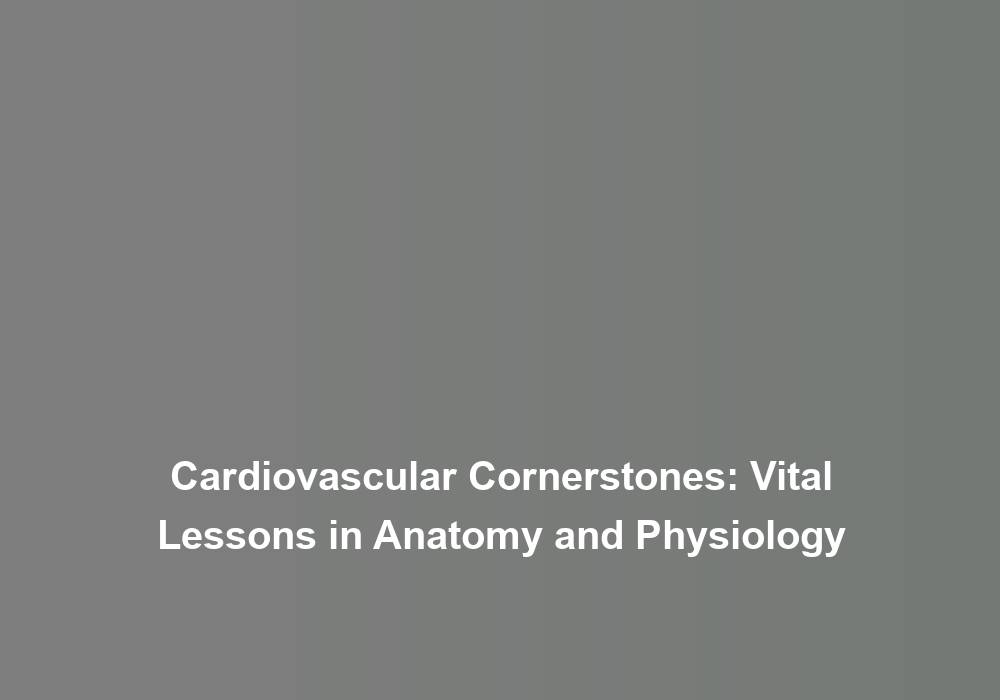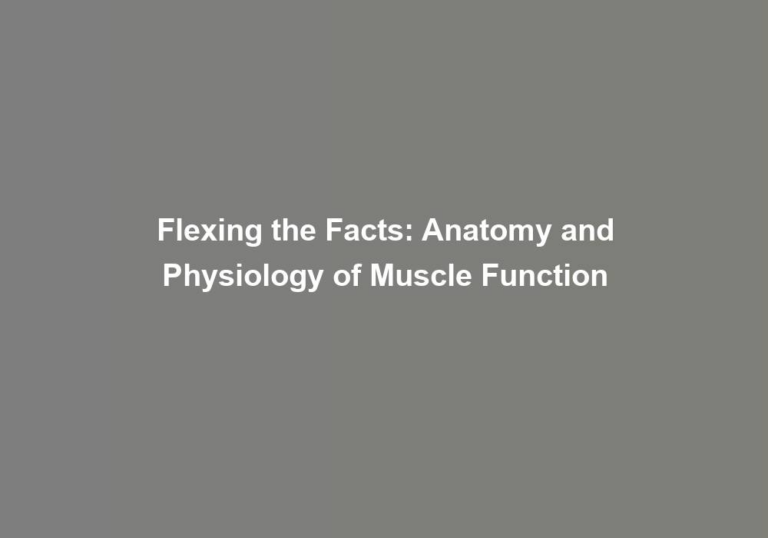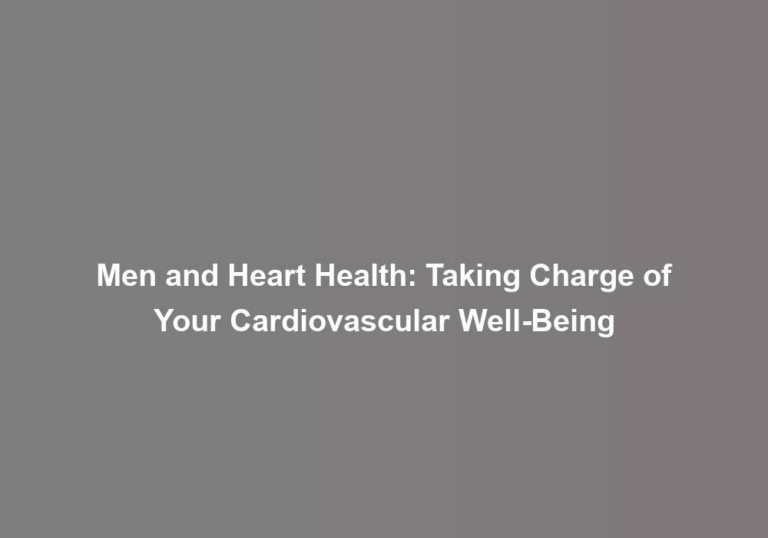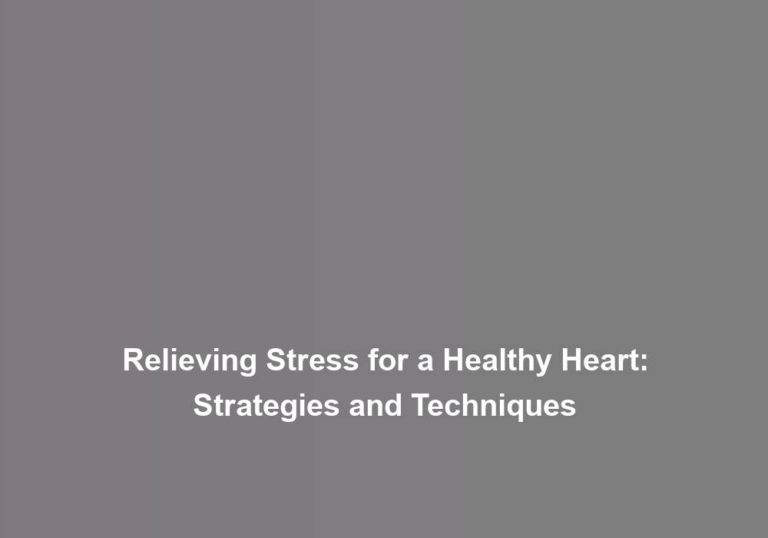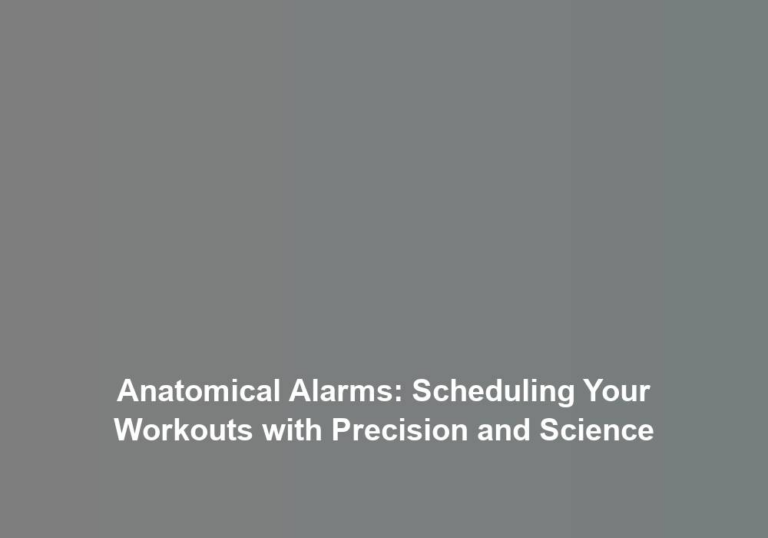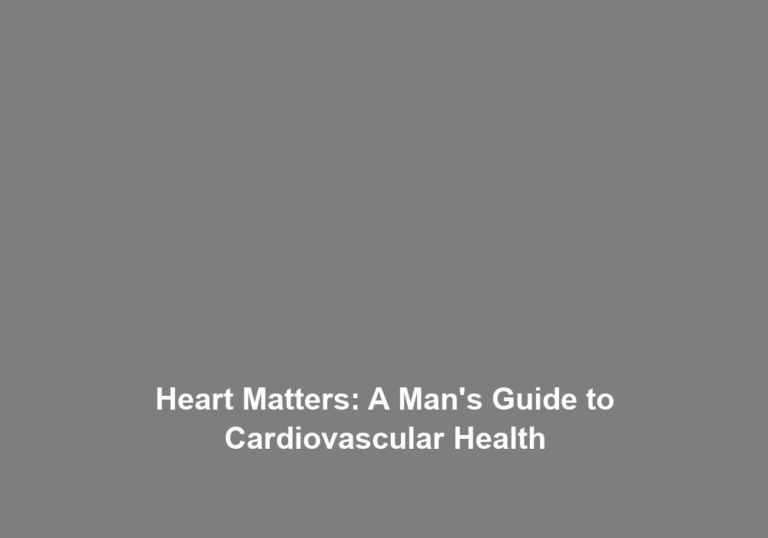Cardiovascular Cornerstones: Vital Lessons in Anatomy and Physiology
YouG??ve probably heard the saying G??follow your heart,G?? but do you really know what that means? Understanding the intricate workings of the cardiovascular system is not just a matter of curiosity; itG??s a vital part of comprehending how your body functions. From the rhythmic beating of the heart to the complex network of blood vessels, the cardiovascular system is a marvel of efficiency and complexity. But what really goes on behind the scenes to keep this system running smoothly, and why is it so crucial to grasp these fundamentals? Understanding these vital lessons in anatomy and physiology will not only give you a deeper appreciation for your body, but also provide insights into how to maintain cardiovascular health and prevent disease.
The Heart: Structure and Function
Understanding the heartG??s structure and function is essential for grasping its role in maintaining cardiovascular health. The heart, a muscular organ about the size of a fist, is divided into four chambers: the left and right atria, and the left and right ventricles. This intricate design allows the heart to efficiently pump oxygenated blood to the body and deoxygenated blood to the lungs. The pumping action of the heart is what keeps the blood flowing through the circulatory system, delivering essential nutrients and oxygen to the bodyG??s tissues and organs while removing waste products.
The heartG??s pumping action is made possible by its unique anatomy. As the heart contracts, the blood is pushed out of the ventricles and into the blood vessels. These blood vessels, including arteries, veins, and capillaries, form a complex network throughout the body. Arteries carry oxygen-rich blood away from the heart, while veins transport oxygen-depleted blood back to the heart. Capillaries, the smallest blood vessels, facilitate the exchange of oxygen, nutrients, and waste products between the blood and the bodyG??s tissues.
Understanding the structure and function of blood vessels is equally important. Arteries have thick, muscular walls to withstand the high pressure of blood being pumped from the heart. Veins, with their thinner walls, rely on one-way valves to prevent the backward flow of blood. Capillaries, on the other hand, have thin walls that allow for the exchange of substances between the blood and tissues. This intricate network of blood vessels plays a vital role in maintaining proper circulation and overall cardiovascular health.
Blood Vessels: Arteries, Veins, and Capillaries
Now letG??s explore the crucial role of blood vessels in your cardiovascular system. Arteries are responsible for delivering oxygen-rich blood to your bodyG??s tissues, while veins bring oxygen-depleted blood back to the heart. Capillaries, on the other hand, facilitate the exchange of nutrients and waste products at the cellular level.
Arterial Function Overview
The arterial system plays a crucial role in transporting oxygenated blood from the heart to the rest of the body, providing vital nutrients and removing waste products. Understanding arterial function is essential for maintaining a healthy cardiovascular system. HereG??s what you need to know:
-
Arterial Elasticity: Arteries have elastic properties that allow them to expand and contract in response to changes in blood pressure, ensuring steady blood flow to tissues and organs.
-
Blood Flow Dynamics: The arteries are responsible for maintaining the steady flow of blood throughout the body, regulating pressure and velocity to meet the varying demands of different tissues and organs.
-
Vital Role: Arteries play a vital role in maintaining overall health by ensuring that oxygenated blood reaches all parts of the body, supporting the delivery of nutrients and removal of waste products. Understanding arterial function is crucial for a healthy cardiovascular system.
Vein Structure Comparison
Veins, like arteries, are essential components of the circulatory system, playing a critical role in returning deoxygenated blood from the bodyG??s tissues back to the heart. When comparing vein structure to arteries, one notable difference is the larger vein diameter, allowing them to hold a higher volume of blood. This larger diameter also facilitates lower blood pressure in veins compared to arteries, enabling smoother blood flow back to the heart. Understanding this structural difference is vital as it impacts the overall functioning of the circulatory system. The efficient blood flow through veins ensures that deoxygenated blood is swiftly returned to the heart, where it can be reoxygenated and recirculated throughout the body. This intricate balance between vein diameter and blood flow is crucial for maintaining optimal cardiovascular health.
Capillary Exchange Process
In the intricate network of blood vessels, capillaries play a pivotal role in facilitating the exchange of nutrients and waste products between the bloodstream and surrounding tissues.
Capillary dynamics influence tissue oxygenation, nutrient delivery, and the exchange process, ensuring that your bodyG??s cells receive the necessary resources and remove waste efficiently.
- Tissue Oxygenation: Capillaries enable the delivery of oxygen to tissues while removing carbon dioxide and other waste products, vital for maintaining cellular function and overall health.
- Nutrient Delivery: Capillaries transport essential nutrients such as glucose, amino acids, and fatty acids to tissues, supporting their growth, repair, and energy production.
- Exchange Process: Capillaries facilitate the exchange of substances between the blood and tissues, allowing for the removal of waste products and the delivery of necessary nutrients, ensuring optimal cellular function.
Cardiac Cycle: Pumping Mechanism
During the cardiac cycle, your heart contracts and relaxes to pump blood throughout your body, ensuring proper circulation and delivery of oxygen and nutrients to your cells. This pumping mechanism occurs in two main phases: diastole and systole. During diastole, your heart muscle relaxes, allowing the chambers to fill with blood. This phase is crucial as it determines the amount of blood that can be pumped out during the next systolic phase. Then comes systole, where the heart muscle contracts, pushing the blood out of the chambers and into the circulation. This coordinated effort of contractility and relaxation is essential for maintaining a healthy heart function.
The heartG??s ability to contract and relax effectively is known as contractility. This refers to the strength and effectiveness of each heartbeat in pumping blood. On the other hand, relaxation of the heart muscle allows the chambers to refill with blood, preparing for the next contraction. Both of these functions are vital for the heart to maintain a steady and efficient pumping action, ensuring that oxygen-rich blood is delivered to the bodyG??s tissues and organs.
Understanding the cardiac cycleG??s pumping mechanism provides insight into the intricate coordination of the heartG??s activities. This knowledge empowers you to appreciate the remarkable function of your heart in sustaining life, fostering a sense of connection with your bodyG??s intricate workings.
Circulatory Pathways: Systemic and Pulmonary
Exploring the circulatory pathways, you will uncover the systemic and pulmonary routes through which blood travels to and from the heart. Understanding these pathways is crucial for comprehending the intricate network that sustains your bodyG??s vital functions.
-
Systemic Circulation: This pathway carries oxygenated blood from the left side of the heart to the bodyG??s tissues and organs, providing them with the oxygen and nutrients they need. As the oxygen is delivered and used up, the blood becomes deoxygenated and returns to the right side of the heart through the systemic circulation.
-
Pulmonary Circulation: In contrast to systemic circulation, pulmonary circulation is responsible for transporting deoxygenated blood from the right side of the heart to the lungs, where it undergoes oxygen exchange. The freshly oxygenated blood is then returned to the left side of the heart to be pumped out to the body again.
-
Oxygen Exchange and Blood Flow Regulation: Within the pulmonary circulation, the exchange of carbon dioxide for oxygen occurs in the alveoli of the lungs, enabling the blood to become oxygenated. Additionally, blood flow through both systemic and pulmonary circulation is regulated by the intricate interplay of various factors, including hormones, neural signals, and local chemical changes.
Understanding the systemic and pulmonary circulatory pathways is essential for appreciating the marvel of bloodG??s journey through your body, nourishing and sustaining every cell and tissue.
Regulation of Blood Pressure and Flow
YouG??ll learn about the intricate mechanisms that regulate blood pressure and control blood flow in the body. Understanding how these processes work will give you insight into the bodyG??s ability to maintain homeostasis and respond to changing physiological demands. LetG??s explore the fascinating ways in which the cardiovascular system adapts to varying conditions to ensure optimal blood pressure and flow.
Blood Pressure Regulation
Understanding blood pressure regulation is crucial for maintaining proper circulation and overall health. It involves a complex interplay of mechanisms that ensure adequate perfusion to vital organs and tissues. HereG??s what you need to know:
-
Baroreceptor reflex: These specialized sensors detect changes in blood pressure and send signals to the brain, which in turn adjusts heart rate and blood vessel diameter to maintain optimal blood pressure.
-
Hormonal regulation: Hormones such as angiotensin II, aldosterone, and antidiuretic hormone play vital roles in regulating blood pressure by affecting blood volume and vessel constriction.
-
Endothelial function: The endothelium, the inner lining of blood vessels, secretes substances that influence vessel tone and blood clotting, thereby contributing to blood pressure regulation.
Understanding these key components of blood pressure regulation empowers you to take active steps in maintaining cardiovascular well-being.
Flow Control Mechanisms
Flow control mechanisms play a crucial role in regulating blood pressure and ensuring proper blood flow throughout the body. Pressure regulation is achieved through the intricate interplay of various mechanisms, including vascular resistance. Your body constantly adjusts the diameter of blood vessels to control the resistance to blood flow, thereby influencing blood pressure. When the vessels constrict, the resistance increases, leading to higher blood pressure. Conversely, when the vessels dilate, the resistance decreases, resulting in lower blood pressure. This dynamic process is meticulously regulated to maintain optimal blood flow to all tissues and organs. Understanding these flow control mechanisms empowers you to appreciate the bodyG??s remarkable ability to adapt and maintain equilibrium. By recognizing the significance of pressure regulation and vascular resistance, you can cultivate a deeper connection with your bodyG??s inner workings.
Cardiovascular Health: Maintenance and Disease Prevention
To maintain cardiovascular health and prevent disease, it is essential to prioritize regular exercise and a balanced diet. Here are three key practices to help you maintain a healthy heart and prevent cardiovascular disease:
-
Regular Exercise: Engaging in physical activity for at least 30 minutes most days of the week can significantly improve cardiovascular health. Aim for a combination of aerobic exercises, such as brisk walking or swimming, and strength training to keep your heart and entire body strong. Find activities that you enjoy, whether itG??s dancing, cycling, or playing sports, to make exercise a fun and sustainable part of your routine.
-
Balanced Diet: Incorporating heart-healthy foods into your diet, such as fruits, vegetables, whole grains, lean proteins, and healthy fats, can help manage your weight, blood pressure, and cholesterol levels. Limiting the intake of processed and high-sugar foods is also crucial for maintaining a healthy heart. Consider consulting with a nutritionist or dietitian to create a personalized meal plan that suits your tastes and lifestyle.
-
Stress Management: Chronic stress can have a negative impact on cardiovascular health. Finding effective stress management techniques, such as meditation, yoga, or deep breathing exercises, can help reduce the strain on your heart and improve overall well-being. Additionally, maintaining strong social connections and seeking support when needed can contribute to better heart health.
Conclusion
Now that you understand the cardiovascular cornerstones, remember that G??an ounce of prevention is worth a pound of cure.G?? Take care of your heart by staying active, eating well, and getting regular check-ups. Your heart is the engine that keeps your body running, so treat it with the care and respect it deserves. By taking proactive steps to maintain cardiovascular health, you can prevent potential problems and live a longer, healthier life.

